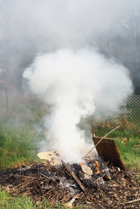Backyard Burning

|

|
Backyard burning refers to the burning of household trash by residents on their own property. Trash typically burned can include paper, cardboard, food scraps, plastics, and yard trimmings-essentially any materials that would otherwise be recycled or sent to a landfill. Burning usually occurs in a burn barrel, homemade burn box, wood stove, outdoor boiler, or open pit. Air emissions from backyard burning are released directly to the atmosphere without being treated or filtered.
Why People Burn their Trash
Backyard burning is common in many areas of the country. People burn trash for various reasons-either because it is easier than hauling it to the local disposal site or to avoid paying for regular waste collection service. In the past, backyard burning may have been the only way that many rural Americans could get rid of their waste. Today, however, almost everyone can obtain reasonably priced waste collection or take their waste to a conveniently located drop-off center as alternatives to backyard burning. Many state, local and tribal governments prohibit or restrict some or all backyard burning of waste. Even where restrictions exist, however, many people continue to burn.
It's a Health Hazard
Most people who burn their waste do not realize how harmful this practice is to their health and to the environment. Current research indicates that backyard burning is far more harmful to our health than previously thought. It can increase the risk of heart disease, aggravate respiratory ailments such as asthma and emphysema, and cause rashes, nausea, or headaches. Backyard burning also produce harmful quantities of dioxins, a group of highly toxic chemicals that settle on crops and in our waterways where they eventually wind up in our food and affect our health. The Human Health page provides more information about the dangers of dioxin.
Burn Barrel Science
Typically, dioxins do not exist in materials before they are incinerated, but are produced when waste is burned. Significantly higher levels of dioxins are created by burning trash in burn barrels than in municipal incinerators. Household burn barrels receive limited oxygen, and thus burn at fairly low temperatures, producing not only dioxins, but a great deal of smoke and other pollutants. Unlike the barrels and boxes used in backyard burning, large incinerators are required by EPA regulations to have stringent pollution control systems that reduce dioxin emissions primarily by preventing their formation. Backyard burning is also particularly dangerous because it releases pollutants at ground level where they are more readily inhaled or incorporated into the food chain. For more information on dioxin formation and sources, visit EPA's Dioxin page.
![[logo] US EPA](../gif/logo_epaseal.gif)